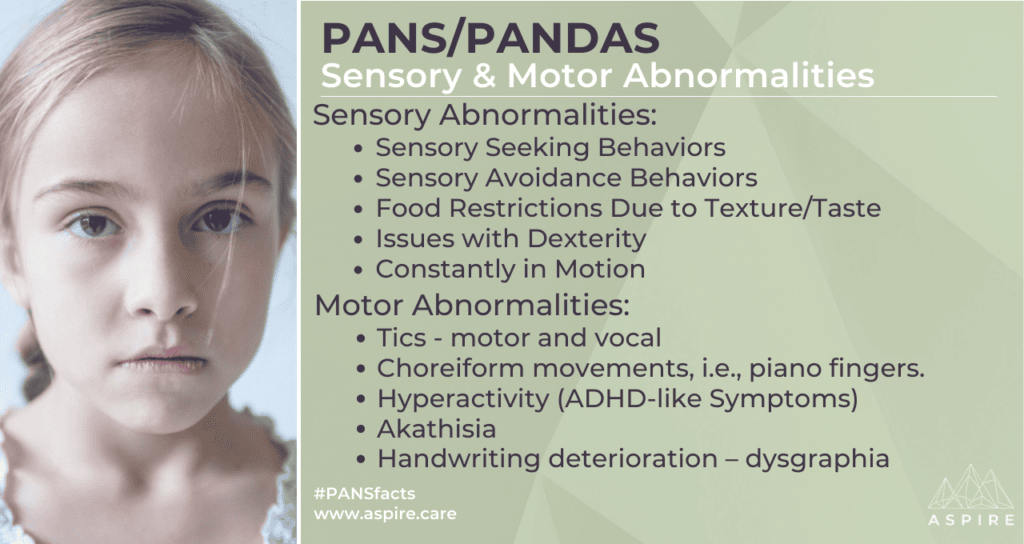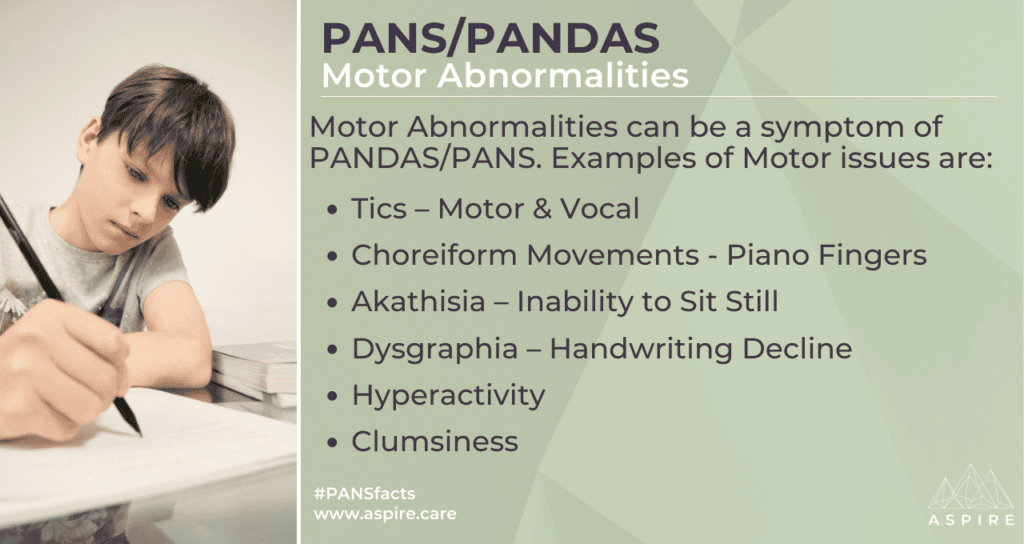Sensory & Motor Abnormalities are one of the main PANS PANDAS symptom categories

In PANS, sensory and motor abnormalities both fall into one of the seven categories of the PANS diagnostic criteria. In PANDAS, motor and vocal tics are one of the two major symptoms of the diagnostic criteria, along with OCD. Tics are not required for either diagnosis. See more about PANS PANDAS Symptoms. PANS/PANDAS is not the same as traditional OCD or a tic disorder; the onset and concurrent symptoms and, in some cases, the severity of the OCD set these disorders apart.
Motor Abnormalities

Motor Abnormalities Overview
Like all PANS PANDAS symptoms, motor abnormalities can look different from patient to patient.
- Tics – motor and vocal
- Can have a dual diagnosis of Tourette’s Syndrome
- Choreiform movements, i.e., piano fingers.
- Not large chorea movements as seen in Sydenham chorea
- Hyperactivity
- Can look like ADHD – See: ADHD-like Symptoms
- Akathisia – A movement disorder that makes it difficult to stay still and causes urges to move that are not controllable.
- Examples are fidgeting, pacing, rock back and forth, crossing and uncrossing legs, or just an uneasy feeling in the body, etc
- Dysgraphia – Handwriting Deterioration
Choreiform Movements – Piano Fingers
Choreiform Movements
Chroreiform movements often seen in PANS PANDAS are different from choreaform movements of Sydenham chorea. Doctors must correctly evaluate involuntary purposeless and uncontrollable movements. Choreiform movements are small and jerky in nature, occurring irregularly and arrhythmically in distal muscles. Choreiforms often look like one is gently playing piano. To evaluate, patients stand with their eyes closed, hands held up in front of them and their fingers slightly separated. After a few moments, fingers will make fined piano-playing movements. In children younger than 5 in patients without PANS PANDAS, similar movements may often be seen, but after age 6, they should be absent. Please note that larger adventitious movements in the shoulders, arms, or trunk may be chorea, requiring a diagnostic work-up for Sydenham chorea. Choreaform movements are described as jerky or writhing, arrhythmic, involuntary movements of the extremities, trunk, and facial muscles
Thank you to Nancy O’Hara, MD, MPH FAAP, for allowing ASPIRE to share this video from your PANS PANDAS Provider Training Membership Program on assessing for Choreiform Movement.
Tics – Motor & Vocal
Tics are sudden, repetitive, involuntary twitches, movements, or sounds. People who have tics cannot stop themselves from doing these movements or sounds. There are two types of tics, motor and vocal, and tics can be simple or complex. Severity can range from mild to severe; severe tics may interfere with daily functioning and communication. Complex tics that are severe and debilitating are characteristic of the tics seen in PANS PANDAS. Tics that proceeded PANS PANDAS onset would not qualify as a meeting the criteria, but preexisting tics that suddenly worsened may qualify. Before the onset of a motor or vocal tic, one may experience an uncomfortable bodily sensation often referred to as a premonitory urge, such as tension, a tingle, or an itch. Some can suppress tics briefly, which causes intense discomfort only relieved by performing the tic/s.
Vocal Tics: repeating phrases, sounds or words, grunting, coughing, hiccupping, humming, throat clearing, yelling a word or phrase, sniffing, clicking noises, squeaking, squealing, whistling, swearing, imitating sounds or words
Motor Tics: A series of repetitive movements in the same order involving several muscle groups, twitching, flinching, head-jerking, eye-blinking or eye-rolling grimacing, shrugging shoulders, jerking an arm, mouth movements, clapping, imitating movements, rude gestures
Simple Tics: Quick, less repetitive movements involving fewer muscles or muscle groups or making a single sound.
Simple Motor Tics – squinting eyes, sniffing, head jerking, nose twitching.
Simple Verbal Tics – barking, throat clearing, a single squeal, coughing, grunting
Complex Tics: Moving several different parts of a body using several muscle groups often with a pattern.
Complex Motor Tics – hopping, jumping, spinning, twisting or bending, gestures, smelling our touching objects.
Complex Verbal Tics – repeating your own or someone else’s words for phrases, obscene words or phrases, mimicking sounds. Can have a combination of Complex verbal and motor tics.
Tourette Disorder: One can have a dual diagnosis of Tourette Disorder and PANS/PANDAS.
Tourette Disorder diagnostic criteria:
- At least one vocal tic and two or more motor tics, although not necessarily at the same time
- Tics occur several times a day, nearly every day or intermittently, for more than a year
- Tics begin before age 18
- Not caused by medications, other substances, or another medical condition like seizures, postviral encephalitis, Huntington disease
- Tics must change over time in location, frequency, type, complexity, or severity
Related Articles:
Dr. Swedo on Tourette Syndrome & PANS
Tourette Syndrome & PANS Overlap
Dysgraphia – Handwriting Deterioration

A change in handwriting may consist of but is not limited to, not being able to write on the lines, poor formation of letters and numbers, reverse letters and numbers (after 2nd grade), poor spacing between numbers, letters, and words, or writing is too large. Margin Drift is also seen.
- See: Occupational Therapy for Handwriting Difficulties for more information and examples.
Sensory Abnormalities

Sensory Processing Overview
Some PANS PANDAS patients have sudden sensory avoidance symptoms while others have sensory-seeking behaviors.
Sensory processing is when the nervous system cannot correctly receive messages from the senses or is unable to provide the appropriate behavioral or motor response. Difficulty in processing sensations creates challenges in every task, creating issues with pain, sound, touch, and feeling and can lead to problems that result in behavior issues, anxiety, depression, and many issues with school work and daily living. Some over-respond (sensory avoidance) to sensations while others may under-respond. Over-responders (sensory seeking) can find even the slightest input, visual or auditory, unbearable. Under-responders may show little to no response to sensory input and be slow to respond to sensation. Hallucinations are included under Sensory Processing Abnormalities.
Some Signs of Sensory Processing Abnormalities:
- Food refusal – certain textures or smells are refused (see more about PANS & Restrictive Eating)
- Extreme irritability when wearing certain clothes
- Resistant to cuddling. Infants arch and pull away from people holding them.
- Unaware they have bumped into objects unless done with force
- Slow to respond to pain
- Overly sensitive to stimulation: touch, noise, smells, etc
- Constantly in motion, body moving, running constantly
- Craves roughhousing
- Uses inappropriate force to handle objects
- Hypotonia – Slouches in chairs. Looks floppy.
- Difficulty playing with toys requiring dexterity
- Difficulty learning new motor skills
- Handwriting skills are difficult
- Babies have difficulty self-soothing
- Clumsy – Doesn’t have a good sense of the relationship between body and space around them.
- Slow to perform tasks
Hallucinations
Patients with PANS PANDAS can have visual hallucinations. These typically manifest as objects that move or change size or as frightening images. Often hallucinations last for a brief period but can last for hours or longer.
According to Dr. Frankovich*, 36% of PANS patients have visual and/or auditory hallucinations. These patients are predominately dealing with higher disease severity. Hallucinations are transient in 83% of those patients. Hallucinations present as non-threatening voices/figures, 6% have delusions, and 6% have thought disorganization. Hallucinations cause a higher caregiver burden.
*As per Dr. Frankovich- SANE conference lecture 2019
Return to PANS PANDAS Symptoms
Return to PANS PANDAS Diagnostic Criteria
